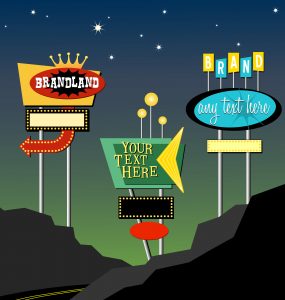
Good signs help businesses stand out, assist with wayfinding, and promote products and services. Using a variety of materials such as aluminum, vinyl, fabric, and plastics, vendors can provide signage for any situation:
- permanent or temporary
- portable or stationary
- indoor and outdoor.
There are countless designs, formats, and styles for business signs, but most of them fall into three distinct categories based on placement:
- Interior signs are placed inside of buildings. Interior signs are used to direct foot traffic in business areas such as shopping malls and retail stores, and to provide directions for visitors to hotels or multi-tenant buildings.
- Exterior (building mounted) signs are connected to the outside of buildings, to be seen by commuters and passersby. Building-mounted signs are easy to spot and put the name of your company where everyone can see it. They can be placed on canopies, in windows, on top of shopping centers with multiple businesses, on roofs, on the sides of buildings, or applied directly to a window using etching or stenciling.
- Exterior (freestanding) signs are self-supporting. They are typically attached to the ground with spikes or screws or stand on poles or legs. The most common freestanding signs we recognize are traffic signs and billboards. Businesses can have freestanding signs that are high-rise or low-rise, are part of a backlit display or awning, or stand at the entrance to your property.
Where do I start?
- Traditional signs are used to enhance the visibility of your
business and to provide guidance to customers. Signs can also be used to
indicate where certain companies are in office buildings, label
executive offices and common areas, and to list prices or menu items.
You can use something as simple as a vinyl banner to advertise a sale,
or as high-tech as a plasma display screen for digital
signage. - You can select from various materials for your signs. Standard sign materials include acrylic, PVC, plastic, wood, and metal. There are also options for neon signs, custom-made awnings, and electronic message boards. And some signs have hardly any “material” at all – one popular type of sign is a silk screen that adheres to windows or glass doors.
- If you have a vision of what type of design you want for your signs, you can present it to a signage vendor to custom build a sign to your liking. They also can develop something that fits your business or use an array of templates with ready-made designs. Signs created from a template cost less than custom signs – and they can be finished more quickly, too.
Signage possibilities
There are nearly limitless uses for signs, some that can last for decades and others that only require a few days of use. Some of the more popular uses for signs include:
- Banners: Clear and prominent messages in a flexible and portable format. Available in a variety of sizes for both indoor and outdoor use.
- Architectural: Permanent designs to display the name of your business inside and outside of your offices.
- Dimensional lettering: Raised, 3D look for permanent signs. You can customize each letter or raise them as part of the overall design.
- Exhibits & displays: Foldable, easily transportable designs for trade shows and special events.
- Lettering & graphics: Etch or apply logos and designs onto glass doors and windows
- Illuminated: For easy viewing day or night.
- Retail: Used for menus, aisle or department markings, posters, and even in-floor designs.
- Yard signs: Commonly used in real estate and politics – easily portable and easily stuck in any lawn.
- Vehicle: Turn automobiles into an advertising opportunity using applied graphics or magnetic panels.
- Safety: For use on roads or in the workplace.
Sign purchasing checklist
Here are some things to keep in mind when shopping for the signs that work best for your business:
- What type of sign do I need?
- What kind of material should be used?
- Have I worked with a sign company before?
- Is this a permanent sign or for temporary purposes?
- Will I need a weatherproof sign?
- Do I want to use my own designs or have a vendor create one?
- Is there any type of warranty on the signs I purchase?
- Can I get volume discounts from my signage provider?
- Who can I contact within my industry for references?
Sign costs
Costs for signs vary greatly depending on the type, size, and material of the sign, as well as how much labour and customization is required. You also have to factor in design services and installation into your total expenses – sometimes shipping as well.
Signage tips
- Check with local zoning laws. There are different rules for sign size, placement, and content. Before you install your sign, make sure you are within legal limitations set by the state, city or town, and building management. A professional sign vendor will know the local rules and regulations.
- The longer a sign vendor has worked in the industry, the more accurate and reliable his quotes will be.
- Some designs and sign types take longer to work with than others.